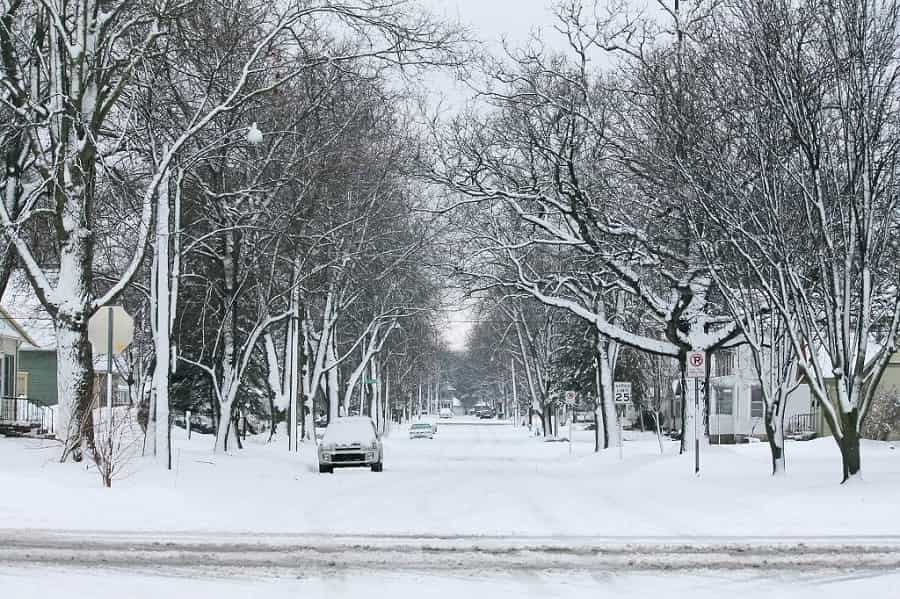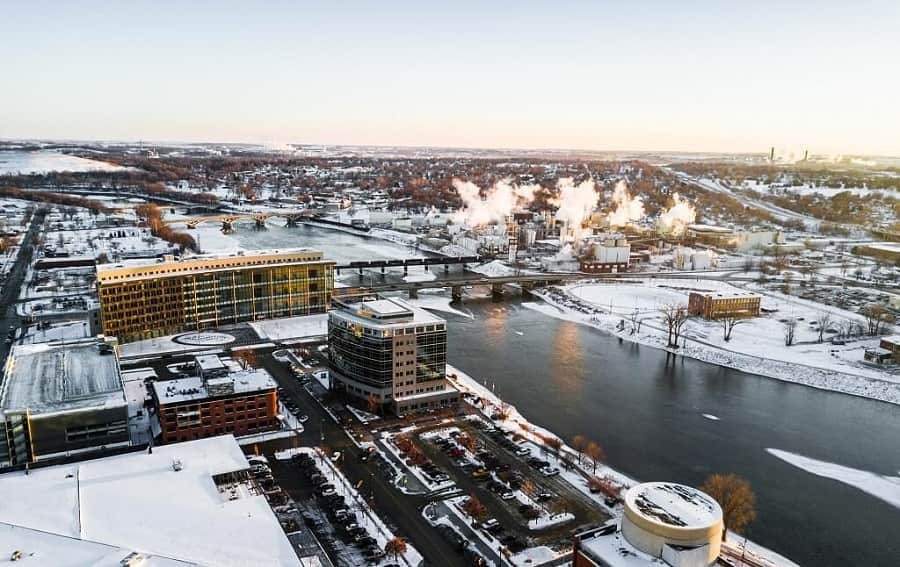Iowa businesses know that sometimes bad weather means bad business, especially during unpleasant winters. Without proper preparation, companies may have reduced foot traffic and revenue during cold months. Not only that but there’s also a greater risk of injury in parking lots and on pathways that haven’t been properly cleared of snow and ice.
This is where having a snow maintenance strategy and dedicated, expert snow removal services can make a huge difference, and part of that is knowing what to expect from winter in Iowa. So, here are our Iowa winter weather predictions for 2023-2024.
Iowa Winter Forecast 2023-2024

As Iowans gear up for the 2023-2024 winter season, several key forecasts have emerged, shedding light on what to expect in terms of temperature, precipitation, and snowfall.
Temperature Outlook
- Warmer than average conditions: According to the National Oceanic and Atmospheric Administration (NOAA), Iowa is expected to experience warmer than average temperatures. This pattern is a common characteristic of El Niño years, affecting most of the northern United States, including Iowa.
- Influence of La Niña: The Climate Prediction Center’s official winter forecast indicates that, like the last two winters, Iowa’s winter temperatures might lean colder due to the influence of La Niña, which historically brings cooler conditions.
Precipitation and Snowfall
- Uncertain precipitation patterns: While there’s no strong indicator of whether Iowa will see more or less precipitation than normal, some El Niño winters have trended slightly wetter in the state, hinting at a possibility of increased precipitation.
- Average snowfall expected: The last two winters, influenced by La Niña, led to average snowfall in Iowa, approximately around 40 inches of snow between December and March. The strength of La Niña plays a crucial role, with stronger La Niña conditions typically resulting in less snow, and weaker La Niña leading to more snow than average.
Key Takeaways
- Adapting to warmer winters: Iowans should prepare for potentially warmer conditions, which may impact winter activities and agricultural practices.
- Precipitation variability: The uncertainty in precipitation patterns necessitates readiness for various scenarios, from drier conditions to potential increased rainfall or snowfall.
- Drought concerns: Ongoing drought conditions in northwestern Iowa are expected to persist, with minimal chances of significant improvement in central and southeastern regions of the state.
- La Niña’s influence: The presence of La Niña suggests a likelihood of cooler temperatures, which could influence energy usage and winter preparedness strategies.
The Framer’s Almanac Forecast for Iowa Winter in 2023-2024
Iowa’s winter 2023-2024 is likely to experience a similar pattern to Wisconsin, with the influence of El Nino affecting the storm tracks. According to Farmer’s Almanac, a stormy winter in Iowa will have blizzard conditions and blowing wet snow in certain areas. The temperatures in Iowa could also be on the colder side, especially in the inland areas. Periods of frigid temperatures and the snowiest periods are likely to be interspersed with occasional warm spells. As part of the north-central United States, Iowa will experience a more snowy and cold winter 2023-2024. It’s essential to be well-prepared for snow removal during this time.
What Was the Iowa Winter Weather 2022-2023?
Winter Weather in December 2022
In December 2022, Iowa experienced below-normal temperatures, with the statewide average temperature at 21.4 degrees, ranking as the 50th coldest December on record. Precipitation was slightly above average, tying 1899 and 1990 as the 34th wettest. Northwestern Iowa faced the coldest conditions with bitterly cold air running rampant, while Donnellson reported an unusually high temperature of 67 degrees. Heating degree day totals were higher than last year, indicating increased home heating requirements. Widespread rainfall occurred, particularly in the drought-stricken northwest, while snowfall averaged 7.8 inches statewide.
Winter Weather in January 2023
In January 2023, Iowa experienced unseasonably warm temperatures, with the statewide average temperature at 24.3 degrees, tying 1983 as the 26th warmest January on record. Precipitation was above average, ranking as the 12th wettest January. Eastern Iowa reported the warmest conditions, while northwestern Iowa had near-average temperatures due to the deep snowpack. Snowfall was also above average, particularly in northern Iowa, with some areas receiving up to 20 inches of snow.
Winter Weather in February 2023
In February 2023, Iowa experienced warmer-than-average temperatures, with the statewide average temperature at 26.3 degrees, ranking as the 46th warmest February on record. Precipitation was above average, making it the 7th wettest February. Eastern Iowa had the warmest conditions, while northwestern Iowa had near-average to slightly more chilly temperatures due to the presence of snowpack. Heating degree day totals were lower than last year and below normal. Precipitation was above average throughout the state, and statewide snowfall averaged 4.3 inches, below normal. The overall winter (December-January-February) was slightly warmer and wetter than normal, with below-average snowfall.
How to Prepare for the Winter Season 2023-2024 in Iowa

Stock Up on Salt
With the winter forecast in Iowa bringing temperamental weather and increased ice, businesses should act now and implement their snow removal and ice management plans. There are three things you can do to prepare for winter snow in Iowa. First and foremost, predictions of increased precipitation indicate a necessary stock-up on salt and deicing agents.
Always store these in cool places to avoid the absorption of moisture. Salt shortages aren’t uncommon, so it’s best to buy in the summer months when there’s still stock. When using salt, be sure to carefully follow instructions to not harm plants, pets, and children.
Account for Any Tripping Hazards
The second thing to see is tripping hazards that, if covered with snow, will pose a danger to pedestrians. Other obstacles like potholes and cracks may be more serious and create long-term risks (when water and snow turn to ice, they expand these fissures).
Seek Help from a Professional Snow Removal Company

Thirdly, it’s always a good idea to employ local snow removal experts. At Earth Development, we have teams throughout Iowa, including Des Moines, Mason City, and Iowa Falls. Many Iowa businesses and families count on us for pre-treatment and ice management to help avoid ice formation on driveways and parking lots.
We’re fully insured, and our experienced team only uses the best equipment to get rid of unwanted snow. Our company also provides outdoor maintenance plans and emergency snow removal services. We are taking requests for snow removal for the next 2023-2024 season!
Get Your Free Snow Removal Quote Today!
Don’t let the unpredictable winter weather in Iowa hinder your business operations. Our team at Earth Development is made up of dedicated winter enthusiasts, all ready to utilize our 20 years of experience in snow removal and ice management to help you throughout the winter months.
Our team is equipped to handle any winter challenge, ensuring that your property remains safe and accessible. Contact us today for a free quote and let us create a customized snow removal plan that meets your specific needs. With our expertise and commitment to exceptional service, you can trust us to keep your business running smoothly, no matter what winter brings.
